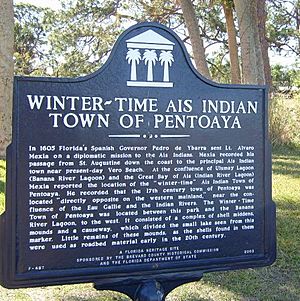Álvaro Mexía facts for kids
Alvaro Mexia was a Spanish explorer and mapmaker from the 1600s. He explored the eastern coast of Florida. Mexia was based in St. Augustine. He had an important job: to make friends with the native groups living south of St. Augustine, especially around Cape Canaveral. His trip helped create a "Period of Friendship" between the Spanish and the Ais people.
Contents
Who Was Alvaro Mexia?
Alvaro Mexia was a key figure in Spanish Florida. He was an explorer and a cartographer. A cartographer is someone who makes maps. He worked for the Spanish government.
Why Was His Mission Important?
In 1605, Pedro de Ibarra became the Governor of Florida. He wanted to improve how the Spanish got along with native groups. So, he sent Mexia on a special mission. Mexia's job was to learn about the lands and people south of St. Augustine. He also helped the Spanish treasure ships. These ships were sailing back to Spain.
Mexia's Journey and Discoveries
Mexia wrote a detailed report about his travels. This report was called a Derrotero. He said it was a "truthful account" of his journey. It described his time among the Ais. Mexia also drew a colorful map. Both his report and map were sent to the King of Spain. Governor Ibarra sent them in a letter.
Places Mexia Visited
Mexia's map and letters showed many native towns. They also named places south of St. Augustine. Here are some of the places he wrote about:
- Surruque: This town was in what is now New Smyrna Beach. Mexia arrived there on June 6, 1605. He stayed for eight days. He waited for orders to go to the Ais Indian Nation.
- Nocoroco: This town was at the mouth of the Tomoka River. It is in Volusia County today.
- Buhio: After Nocoroco, Mexia saw a buhio. This is a word for a native hut. Some of these huts were very large. They could hold thousands of people.
- Caparca: This site is near present-day New Smyrna.
- Potopotoya: This was near the Haulover Canal. Native Americans used this spot to carry their canoes across land.
- Savo: Another place Mexia noted on his journey.
- Lagoon of Sababoche: This is the southern part of today's Banana River.
- Town of Savochequeya: This is now Newfound Harbor on Merritt Island, Florida.
- Lagoon of Ulumay: This is the Banana River Lagoon. It is north of the Lagoon of Sababoche.
- Pentoaya: Mexia traveled through a narrow passage called "Callejon" to reach Pentoaya. This area is now Indian Harbor Beach and Eau Gallie.
- Grand Bay of Ais: He crossed this large bay.
- Small Islands: He saw two small islands in the Indian River Lagoon. One was Grant Farm Island.
- Fresh Water River: He reached a small river. Today, it is called the Sebastian River.
- Great Indian Town of the Ais: This was the main Ais town. It is now known as the Kroegel Homestead.
Success of the Mission
Alvaro Mexia returned to St. Augustine. He gave his report to Governor Ibarra on July 11, 1605. This was more than a month after he left. His mission was a big success.
Agreements with the Ais
On September 2, 1605, an important Ais leader arrived in St. Augustine. He was called Capitan Grande. He came with his mandador (a kind of deputy chief). The chiefs of Surruque and other towns also came. They brought twenty other Ais people. They made important agreements. The Ais agreed to return shipwrecked sailors to the Spanish. In return, the Spanish would pay them a ransom. This helped build a period of friendship.
See Also
- Ais people
- Pedro de Ibarra (governor of La Florida)
- St. Augustine, Florida


